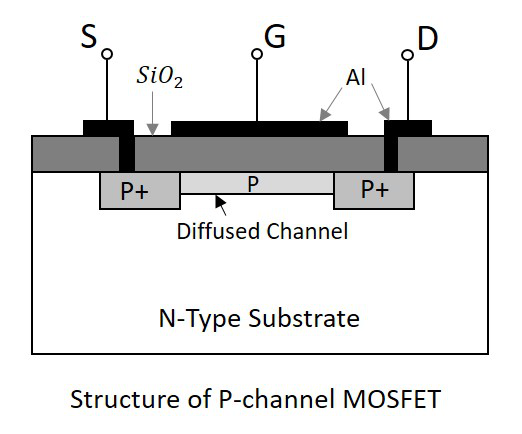MOSFET mŏs ′fĕt′ Short for metal-oxide semiconductor field effect transistor. A type of field effect transistor, used predominantly in microprocessor and related technology, that consumes very little. An N-Channel MOSFET is made up of an N channel, which is a channel composed of a majority of electron current carriers. The gate terminals are made up of P material. Depending on the voltage quantity and type (negative or positive) determines how the transistor operates whether it turns on or off. It is the maximum current in the tolerance range of drain-source voltages, V DS, that can be achieved. I DSS is referred to as the drain current for zero bias, because the gate-source voltage requires no bias voltage to operate. The gate-source voltage is just zero. No voltage needs to be applied to it. A metal-oxide-semiconductor field-effect transistor (MOSFET) is a voltage-controlled electronic component invented by a South Korean Engineer Dawon Kahng, and his colleague Martin M. Atalla in 1959 whilst working at Bell Labs.
The threshold voltage, commonly abbreviated as Vth, of a field-effect transistor (FET) is the minimum gate-to-source voltage VGS (th) that is needed to create a conducting path between the source and drain terminals. It is an important scaling factor to maintain power efficiency.
When referring to a junction field-effect transistor (JFET), the threshold voltage is often called pinch-off voltage instead.[1][2] This is somewhat confusing since pinch off applied to insulated-gate field-effect transistor (IGFET) refers to the channel pinching that leads to current saturation behaviour under high source–drain bias, even though the current is never off. Unlike pinch off, the term threshold voltage is unambiguous and refers to the same concept in any field-effect transistor.
Mosfet Meaning In Electronics Technology
Basic principles[edit]
In n-channelenhancement-mode devices, a conductive channel does not exist naturally within the transistor, and a positive gate-to-source voltage is necessary to create one such. The positive voltage attracts free-floating electrons within the body towards the gate, forming a conductive channel. But first, enough electrons must be attracted near the gate to counter the dopant ions added to the body of the FET; this forms a region with no mobile carriers called a depletion region, and the voltage at which this occurs is the threshold voltage of the FET. Further gate-to-source voltage increase will attract even more electrons towards the gate which are able to create a conductive channel from source to drain; this process is called inversion. The reverse is true for the p-channel 'enhancement-mode' MOS transistor. When VGS = 0 the device is “OFF” and the channel is open / non-conducting. The application of a negative (-ve) gate voltage to the p-type 'enhancement-mode' MOSFET enhances the channels conductivity turning it “ON”.
In contrast, n-channel depletion-mode devices have a conductive channel naturally existing within the transistor. Accordingly, the term threshold voltage does not readily apply to turning such devices on, but is used instead to denote the voltage level at which the channel is wide enough to allow electrons to flow easily. This ease-of-flow threshold also applies to p-channeldepletion-mode devices, in which a negative voltage from gate to body/source creates a depletion layer by forcing the positively charged holes away from the gate-insulator/semiconductor interface, leaving exposed a carrier-free region of immobile, negatively charged acceptor ions.
For the n-channel depletion MOS transistor, a negative gate-source voltage, -VGS will deplete (hence its name) the conductive channel of its free electrons switching the transistor “OFF”. Likewise for a p-channel 'depletion-mode' MOS transistor a positive gate-source voltage, +VGS will deplete the channel of its free holes turning it “OFF”.
In wide planar transistors the threshold voltage is essentially independent of the drain–source voltage and is therefore a well defined characteristic, however it is less clear in modern nanometer-sized MOSFETs due to drain-induced barrier lowering.
In the figures, the source (left side) and drain (right side) are labeled n+ to indicate heavily doped (blue) n-regions. The depletion layer dopant is labeled NA− to indicate that the ions in the (pink) depletion layer are negatively charged and there are very few holes. In the (red) bulk the number of holes p = NA making the bulk charge neutral.

If the gate voltage is below the threshold voltage (left figure), the 'enhancement-mode' transistor is turned off and ideally there is no current from the drain to the source of the transistor. In fact, there is a current even for gate biases below the threshold (subthreshold leakage) current, although it is small and varies exponentially with gate bias.
If the gate voltage is above the threshold voltage (right figure), the 'enhancement-mode' transistor is turned on, due to there being many electrons in the channel at the oxide-silicon interface, creating a low-resistance channel where charge can flow from drain to source. For voltages significantly above the threshold, this situation is called strong inversion. The channel is tapered when VD > 0 because the voltage drop due to the current in the resistive channel reduces the oxide field supporting the channel as the drain is approached.
Body effect[edit]
What Is Mosfet In Electronics
The body effect is the change in the threshold voltage by an amount approximately equal to the change in the source-bulk voltage, , because the body influences the threshold voltage (when it is not tied to the source). It can be thought of as a second gate, and is sometimes referred to as the back gate,and accordingly the body effect is sometimes called the back-gate effect.[3]
For an enhancement-mode nMOS MOSFET, the body effect upon threshold voltage is computed according to the Shichman–Hodges model,[4] which is accurate for older process nodes,[clarification needed] using the following equation:
where is the threshold voltage when substrate bias is present, is the source-to-body substrate bias, is the surface potential, and is threshold voltage for zero substrate bias, is the body effect parameter, is oxide thickness, is oxide permittivity, is the permittivity of silicon, is a doping concentration, is elementary charge.
Dependence on oxide thickness[edit]
In a given technology node, such as the 90-nm CMOS process, the threshold voltage depends on the choice of oxide and on oxide thickness. Using the body formulas above, is directly proportional to , and , which is the parameter for oxide thickness.
Thus, the thinner the oxide thickness, the lower the threshold voltage. Although this may seem to be an improvement, it is not without cost; because the thinner the oxide thickness, the higher the subthreshold leakage current through the device will be. Consequently, the design specification for 90-nm gate-oxide thickness was set at 1 nm to control the leakage current.[5] This kind of tunneling, called Fowler-Nordheim Tunneling.[6]
where and are constants and is the electric field across the gate oxide.
Before scaling the design features down to 90 nm, a dual-oxide approach for creating the oxide thickness was a common solution to this issue. With a 90 nm process technology, a triple-oxide approach has been adopted in some cases.[7] One standard thin oxide is used for most transistors, another for I/O driver cells, and a third for memory-and-pass transistor cells. These differences are based purely on the characteristics of oxide thickness on threshold voltage of CMOS technologies.
Temperature dependence[edit]
What Is A Mosfet Amplifier
As with the case of oxide thickness affecting threshold voltage, temperature has an effect on the threshold voltage of a CMOS device. Expanding on part of the equation in the body effect section
where is half the contact potential, is Boltzmann's constant, is temperature, is the elementary charge, is a doping parameter and is the intrinsic doping parameter for the substrate.

We see that the surface potential has a direct relationship with the temperature. Looking above, that the threshold voltage does not have a direct relationship but is not independent of the effects. This variation is typically between −4 mV/K and −2 mV/K depending on doping level.[8] For a change of 30 °C this results in significant variation from the 500 mV design parameter commonly used for the 90-nm technology node.
Dependence on random dopant fluctuation[edit]

Random dopant fluctuation (RDF) is a form of process variation resulting from variation in the implanted impurity concentration. In MOSFET transistors, RDF in the channel region can alter the transistor's properties, especially threshold voltage. In newer process technologies RDF has a larger effect because the total number of dopants is fewer.[9]
Research works are being carried out in order to suppress the dopant fluctuation which leads to the variation of threshold voltage between devices undergoing same manufacturing process.[10]
See also[edit]
References[edit]
- ^'Junction Field Effect Transistor (JFET)'(PDF). ETEE3212 Lecture Notes.
This is called the threshold, or pinch-off, voltage and occurs at vGS=VGS(OFF).
- ^Sedra, Adel S.; Smith, Kenneth C. '5.11 THE JUNCTION FIELD-EFFECT TRANSISTOR (JFET)'(PDF). Microelectronic Circuits.
For JFETs the threshold voltage is called the pinch-off voltage and is denoted VP.
- ^Marco Delaurenti, PhD dissertation, Design and optimization techniques of high-speed VLSI circuits (1999))Archived 2014-11-10 at the Wayback Machine
- ^NanoDotTek Report NDT14-08-2007, 12 August 2007
- ^Sugii, Watanabe and Sugatani. Transistor Design for 90-nm Generation and Beyond. (2002)
- ^S. M. Sze, Physics of Semiconductor Devices, Second Edition, New York: Wiley and Sons, 1981, pp. 496–504.
- ^Anil Telikepalli, Xilinx Inc, Power considerations in designing with 90 nm FPGAs (2005))[1]
- ^Weste and Eshraghian, Principles of CMOS VLSI Design : a systems perspective, Second Edition, (1993) pp.48 ISBN0-201-53376-6
- ^Asenov, A. Huang,Random dopant induced threshold voltage lowering and fluctuations in sub-0.1 μm MOSFET's: A 3-D “atomistic” simulation study, Electron Devices, IEEE Transactions, 45 , Issue: 12
- ^Asenov, A. Huang,Suppression of random dopant-induced threshold voltage fluctuations in sub-0.1-μm MOSFET's with epitaxial and δ-doped channels, Electron Devices, IEEE Transactions, 46, Issue: 8
External links[edit]
- Online lecture on: Threshold Voltage and MOSFET Capacitances by Dr. Lundstrom
IDSS (referred to as the drain current for zero bias) is the maximum current that flowsthrough a FET transistor, which is when the gate voltage, VG, supplied to the FET is 0V.
When the gate voltage decreases for N-Channel FETs, or increases for P-Channel FETs, the drain current ID becomes smaller and smaller, until after a certain threshold, the transistor shuts off.
The current, IDSS, is important because it's the maximum current that a FET can reach without entering the restricted breakdown region. It is the maximum current in the tolerance range of drain-source voltages, VDS, that can be achieved.
IDSS is referred to as the drain current for zero bias, because the gate-source voltagerequires no bias voltage to operate. The gate-source voltage is just zero. No voltage needs to be applied to it.
